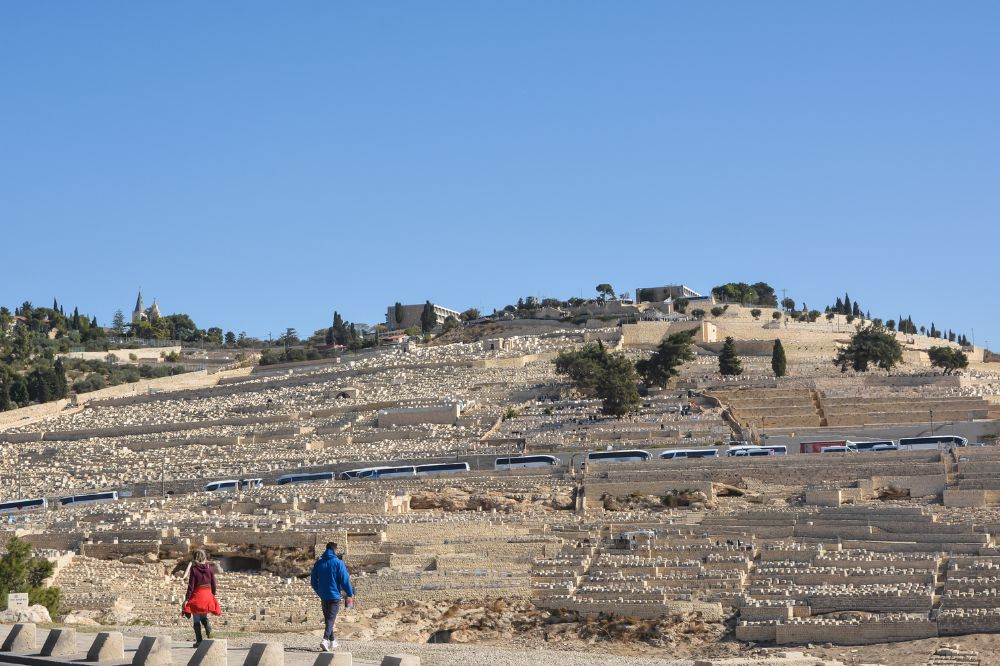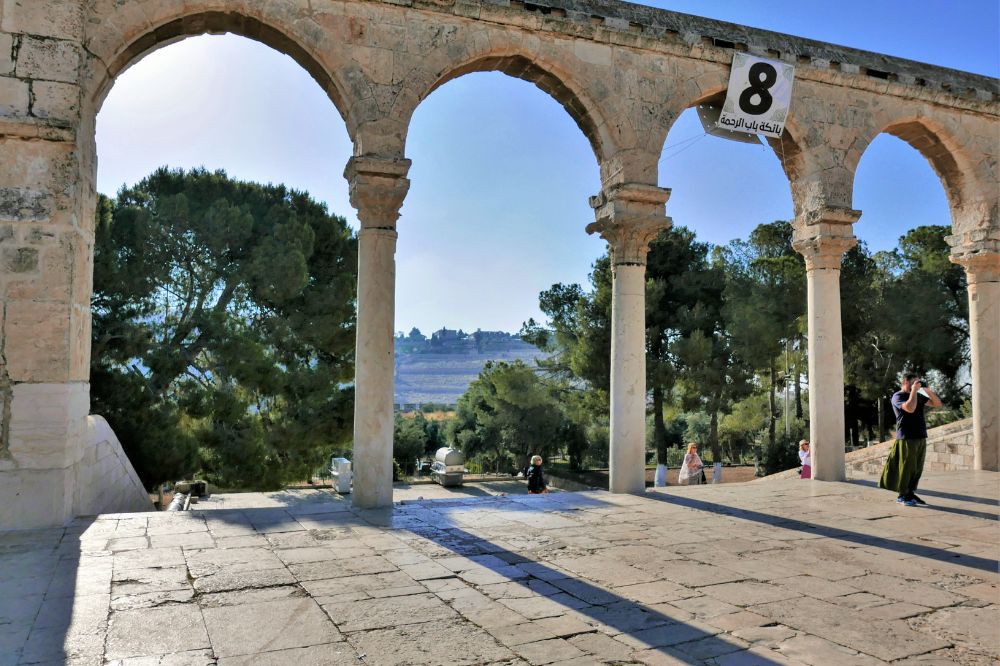
A place that embodies the very essence of the Holy Land is the Mount of Olives. This historic site is an epicenter of reflection and revelation for millions of believers from various religious traditions.
From time immemorial, it has witnessed transcendental events that have left a profound mark on history and faith. For Christians, its importance lies in being the place from which, according to the Gospels, Jesus ascended to heaven after his resurrection. For Jews and Muslims, this mount also holds deep spiritual and symbolic value.

Walking through the Mount of Olives, you will be following in the footsteps of important biblical figures. This mount, mentioned in numerous scriptures, is a crucible of history and spirituality. Since biblical times, it has been a place of great significance.
Jesus, along with his disciples, used to frequent it to pray and teach. They climbed this mount after the Last Supper, where he prophesied his own betrayal; there he also experienced the Agony in the Garden and prayed before his arrest. These events have promoted pilgrimages for centuries, creating a deep bond between faith and the sacred land.
Reading the pages of the Old Testament, you will discover various references to the Mount of Olives, known for its prophetic significance. Prophets like Zechariah mention this place as the scene of future events. It is also associated with divine judgment and redemption.
In the book of Ezekiel, the glory of God returning to the mount is prophesied. Additionally, the Mount of Olives is the site where King David fled during the rebellion of his son Absalom.
But its greatest biblical resonance is found in the New Testament, especially in the accounts of Jesus’s life. Here, in Gethsemane, at the foot of the mount, Jesus faced his most anguishing moment before his crucifixion. These biblical connections endow the Mount of Olives with an aura of mystery and transcendence, attracting believers from all over the world.
Throughout the centuries, the Mount of Olives has witnessed a constant flow of devotees and pilgrims seeking spiritual inspiration in the Holy Land. Since ancient times, pilgrims from various cultures have ascended its slopes in search of divine connections.
During the medieval era, monasteries and hermitages were erected on its summits, making it a center of Christian devotion. Later, during the Ottoman rule and the British mandate, the mount continued to be a place of religious and cultural interest.
In modern times, its importance persists, attracting visitors from all over the world who also seek to visit the tomb of Jesus and other significant sites in the scriptures.

The Mount of Olives is full of hidden treasures where history and spirituality intertwine in a unique tapestry of experiences. Let yourself be amazed by the eternal beauty of this sacred place, where every corner holds secrets to be discovered.
The Garden of Gethsemane, an oasis of peace on the Mount of Olives, is a place of deep religious and spiritual significance. Here, among the ancient olive trees, it is said that Jesus spent his most anguished moments before his arrest. This garden witnesses his agony and his submission to the divine will.
Today, pilgrims flock to this site to reflect and pray, feeling the presence of the Sacred in every corner. Nearby is the Western Wall, a sacred symbol for Judaism, adding an additional layer of spiritual significance to this area.
The Church of All Nations, also known as the Church of All Nations, is a place of veneration and contemplation on the Mount of Olives.
Its construction dates back to the 20th century, funded by donations from various nations. The church’s architectural design stands out for its neo-Byzantine style, with mosaics and columns that evoke an atmosphere of solemnity and reverence.
This place is significant for Christians, as it is located on the traditional site where Jesus prayed in agony before his arrest. For pilgrims, visiting this church is an opportunity to connect with Jesus’s spiritual experience in his most difficult hour.

On the Mount of Olives lies a place of profound devotion: the Tomb of the Virgin Mary. According to Christian tradition, this site is where Mary, the mother of Jesus, was buried and ascended to heaven. The history of this tomb dates back to ancient times, and its spiritual importance transcends religious boundaries.
For the faithful of the Orthodox and Catholic Christian faiths, visiting this sacred place is an act of veneration and piety. It is believed that Mary’s presence remains palpable here, offering comfort and hope to those who seek her.
The Chapel of the Ascension, located on the Mount of Olives, is a site of deep theological and historical significance for Christian believers. This small chapel marks the traditional exact spot from where Jesus ascended to heaven after his resurrection.
Originally built in the 4th century, the chapel has been restored and renovated over the centuries but still retains its spiritual and architectural essence. Its simple and serene interior invites reflection and prayer, while its location at the top of the mount offers impressive views of Jerusalem and its surroundings.
As a pilgrim, you are awaited by a journey full of meaning and reflection in this sacred place of the Holy Land. From the ancient alleys to the revered places of worship, each step you take will bring you closer to history and faith. Discover the spiritual richness of this place while living an experience that will touch your heart and renew your soul.
Before embarking on your pilgrimage to the Mount of Olives, it is important to consider several practical aspects to ensure a smooth and meaningful experience:

For a complete experience on the Mount of Olives, we suggest following this route:
To make the most of your visit to the Mount of Olives, here are some practical tips:
Exploring the Mount of Olives gives you the opportunity to establish meaningful connections with other sacred sites in the Holy Land region.
These connections between the Mount of Olives and other sacred sites will enrich your experience.

Next, you will receive reflections on the faith, history, and significance of this sacred place. Through carefully selected reflections, we invite you to contemplate the universal teachings the mount offers and to deepen your own understanding of the spirit.
The Ascension of Jesus, a central event in the Christian faith, offers multiple theological perspectives and profound implications for believers. From a theological perspective, it represents the exaltation of Jesus to heaven and his return to the Father. It is seen as the culmination of his redemptive work and the beginning of his glorious reign.
For Christians, this doctrine supports the hope of eternal life and the promise of his return. Furthermore, the Ascension affirms the divinity of Jesus and his authority over all creation. In practical terms, it challenges believers to live in anticipation of his return and to carry out the mission of proclaiming the Gospel to the world.
Prayer on the Mount of Olives offers a unique experience of spiritual connection and deep reflection.
This sacred place, steeped in history and religious significance, invites pilgrims to experience the divine presence and deepen their personal prayer life. Walking its paths lined with ancient olive trees, you can find moments of silence and contemplation to commune with the sacred.
You can take advantage of the various prayer sites to seek intimacy with the divine and express your deepest longings and concerns.
The Mount of Olives, with its rich symbolism in the Christian faith, offers profound spiritual lessons for believers. The olive trees, symbols of peace and fertility, represent the divine presence and God’s provision in the lives of his followers.
Olive oil, extracted from the fruits of these trees, symbolizes the anointing of the Holy Spirit and spiritual healing.
In the Scriptures, the Mount of Olives serves as a backdrop for transcendental events, such as the Ascension of Jesus, marking his glorious departure to heaven. This mountain is also associated with the coming of the Messiah in the Second Coming, a reminder of hope and the promise of redemption for believers.
In contemporary life, the symbolism of the Mount of Olives invites believers to seek inner peace, spiritual renewal, and preparation for the Lord’s coming in their lives.
Stay Connected with WayHoly
Discover your perfect pilgrimage and be the first to know about new journeys. By subscribing to our newsletter, you’ll receive the latest updates on pilgrimages, exclusive offers, and spiritual resources to enrich your faith journey.
Don’t miss the opportunity to deepen your connection with God and lead others on their path to spiritual renewal. Join us today and become an instrument of His Will through WayHoly!
Support Our Mission
Help us continue spreading faith and hope. Your generous donation fuels our work, allowing us to guide more souls on their pilgrimage toward God.
Contact
Pages
Newsletter
Join our community and transform your pilgrimage experience with WayHoly. Receive the latest updates, exclusive offers, and spiritual insights.
“To upload your pilgrimage, please choose one of our plans and create an account, or log in if you’re already a member. Join us in guiding others on their spiritual journey.”